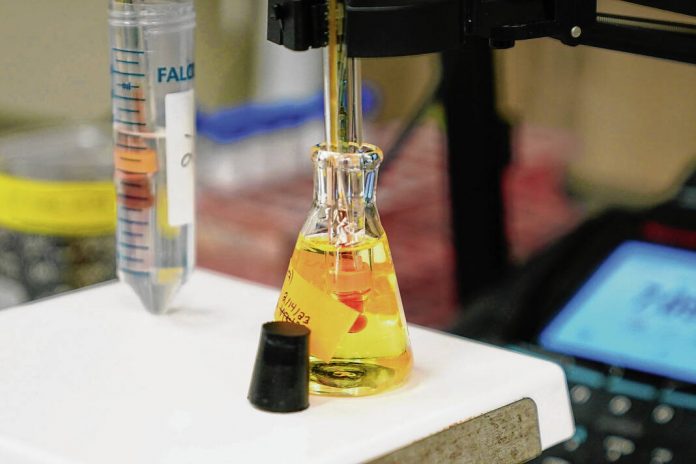
AP Photo/Joshua A. Bickel A water sample is measured as part of a PFAS drinking water treatment experiment, Tuesday, Feb. 14, 2023, at the U.S. Environmental Protection Agency Center For Environmental Solutions and Emergency Response in Cincinnati.
Local officials have said that they expect to receive supplies from state regulators within the next month to start testing Columbus’ drinking water for long-lasting and highly toxic chemicals linked to cancer and other illnesses.
The Indiana Department of Environmental Management has informed Columbus City Utilities that it is ready to proceed with testing the city’s 19 wells and both water plants for a class of chemicals called PFAS, said city utilities director Roger Kelso. The testing is part of an effort to examine the prevalence of the chemicals in public water systems across the state and test the efficacy of drinking water treatment, state officials said earlier.
PFAS, or per- and polyfluoroalkyl substances, are a cluster of industrial chemicals associated with a variety of serious health conditions and have been used in products ranging from cookware to carpets and firefighting foams and consumer products since the 1940s, according to the U.S. Environmental Protection Agency.
Research suggests exposure to certain levels of PFAS can lead to reproductive effects in humans, developmental delays, increased risks for certain cancers, elevated cholesterol levels and weakening of the immune system, according to the EPA.
The chemicals are sometimes called “forever chemicals” because they don’t break down naturally in the environment — or do so slowly — and can remain in a person’s blood indefinitely. U.S. manufacturers have voluntarily phased out compounds such as PFAS, though there still are a limited number of ongoing uses for them.
“They’re en route,” Kelso said of the testing supplies. “I don’t know the exact date that I’m going to get the bottles and stuff in to do it, but very shortly — easily within 30 days, if not sooner,” Kelso said.
Though Columbus City Utilities does not currently test for PFAS, officials believe that it is it is unlikely that the chemicals will be detected in Columbus’ water.
The utility’s most recent water quality report shows that Columbus’ drinking water met all state and federal standards. PFAS are not a required item for the city to test for, Kelso said in a previous interview.
However, if something was detected, it would not be the first time that an unregulated contaminant was found in Columbus’ water supply. In 2017, two wells were shut down after tests revealed the presence of low amounts of 1,4 dioxane, an organic chemical used as an industrial solvent that the EPA considers to be a “likely human carcinogen.”
Proposed federal limits
The testing comes weeks after the U.S. Environmental Protection Agency proposed the first federal limits on PFAS, a long-awaited protection the agency said will save thousands of lives and prevent serious illnesses, including cancer, The Associated Press reported.
The proposal would set strict limits of 4 parts per trillion, the lowest level that can be reliably measured, for two common types of PFAS compounds called PFOA and PFOS, according to wire reports. In addition, the EPA wants to regulate the combined amount of four other types of PFAS. Water providers will have to monitor for PFAS.
The public will have a chance to comment, and the agency can make changes before issuing a final rule, expected by the end of the year.
If the EPA ends up moving forward with the limits, Columbus City Utilities would eventually be required to test for them annually, Kelso said. “They would eventually become part of our required monitoring and, potentially, treatment process,” he said.
Nationally, it could cost roughly $38 billion to remove enough of the chemicals to meet a strict EPA rule limiting them to where they can’t be detected, according to an estimate prepared by engineering consultant Black & Veatch for the American Water Works Association, an industry group. There also will be ongoing costs for filter material and testing.
The consultant looked at federal and state test results and estimated that 4% to 12% of water providers nationally will need to treat for PFAS due to the EPA rule, according to wire reports.
Testing efforts
IDEM began testing certain participating public water systems for PFAS in February 2021. The effort has been broken into phases based off community size, with Columbus in the third phase of testing, which includes water systems that serve more than 10,000 people, IDEM spokesman Barry Sneed said.
The first phase of testing took place last year and included communities with populations between 3,300 to 10,000 people. During that phase, state officials detected PFAS in treated drinking water in 10 counties, mainly in central and southern Indiana, according to IDEM.
The results of the second phase of testing, which included water systems serving fewer than 3,300 people, were not yet available on IDEM’s website.
The Nashville Water Department and North Vernon Water Department were included in the first round of testing, but no PFAS were detected in treated or untreated water at either utility.
However, PFAS were detected in untreated water at the Edinburgh Water Utility but not in finished drinking water.
IDEM also tested the water supply at Camp Atterbury and did not detect PFAS. But contractors in a separate testing effort detected PFAS in the groundwater near a storage site on the north side of the base, though “it does not impact the Camp Atterbury water supply,” officials said earlier this year.
The contamination may be related to the storage of firefighting foam that contained PFAS.
Sneed said IDEM anticipates making the results of the third phase of testing public within 45 days after receiving the results from the lab.
“For each community water system, if no PFAS are detected there will just be one round of sampling,” Sneed said. “If PFAS are detected, confirmation/follow-up samples may be collected.”
IDEM will be the first of three regulators who will test at least part of Columbus’ drinking water for PFAS in the next couple years.
The U.S. Geological Survey plans to collect water quality samples this year from two monitoring wells owned by Columbus City Utilities to access groundwater availability for the southeast I-74 water study, Kelso said. The water will be analyzed for a range of substances, including PFAS.
In addition, the EPA plans to conduct mandatory PFAS testing in Columbus in July 2024 and January 2025, officials said previously.
“(There is) a lot of testing going on,” Kelso said.
Exposure
People can be exposed to PFAS in a variety of ways, according to the EPA.
The chemicals can be found in water, soil, air, food and numerous consumer products, including cleaning products, non-stick cookware, shampoo, dental floss and cosmetics.
Because PFAS have been used in many consumer products — in some cases since the 1940s — researchers believe that most Americans have been exposed to them.
Many people come into contact with PFAS by drinking contaminated water or eating food raised or grown around places where PFAS were made or used.
The chemicals first started showing up in human blood tests in the 1960s, according to the Centers for Disease Control and Prevention. By the turn of the century, an estimated 98% of Americans had detectable levels of PFAS in their blood.
Chemical manufacturing workers and firefighters are believed to be among those with the highest risk of exposure, according to the CDC.
One source of PFAS exposure that is drawing the attention of environmental regulators is a firefighting foam that has been used by fire departments across the country for decades, including in Columbus.
The foam, known as Class B aqueous film forming foam, or AFFF, is generally used to extinguish flammable liquid fires, particularly in incidents involving aircraft.
The Columbus Fire Department had 300 gallons of PFAS-containing foam as of May 2022, when state officials helped the department safely dispose of the material, said Columbus Fire Department spokesman Capt. Mike Wilson this past July.
The foam was stored in five-gallon buckets in the department’s garage facility in the Columbus Air Park, Wilson said previously. The material was removed at no charge to the department.
Wilson couldn’t recall the last time that Columbus firefighters used the foam because the department doesn’t often deal with aircraft incidents. Local firefighters do not train with that type of foam, he said.




